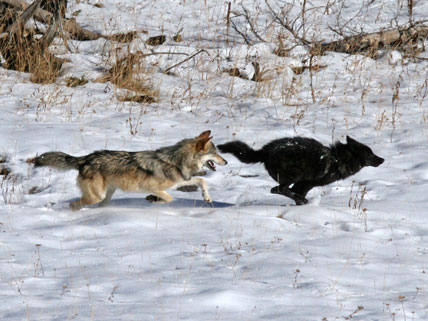 Playful wolf siblings belonging to the Druid Peak pack in Yellowstone National Park
Playful wolf siblings belonging to the Druid Peak pack in Yellowstone National Park
The wolves of Yellowstone National Park present a study in complex ecological relationships. What effects do predators have on an ecosystem? Looked at another way, what effects does their absence have? An apex predator is the species that sits atop a food chain—lions in Africa, tigers in Asia, bears, sharks. For millennia wolves were the “top dogs” of the Rocky Mountain wilderness. But then a new predator moved in—not one that fed on wolves, but one who disapproved what the wolves were feeding on. Humans valued livestock raising more than they valued wilderness.
Wolves were hunted to near-extinction because they tended to attack grazing cattle, when they weren’t stalking elk, deer, and antelope. In 1915, the U.S. government began underwriting wolf eradication on federal lands. The last lone wolf in Yellowstone was exterminated in 1926. By 1944, wolves were effectively extinct in the northern Rockies. Thus closed a chapter on wolf in the West—but not the final one.
From the 1960s wildlife biologists began recommending wolf restoration to Yellowstone; in 1974, wolves in Wyoming and Montana received federal protection through the Endangered Species Act. The U.S. Fish and Wildlife Service and National Park Service, as well as groups like the National Wildlife Federation, embraced the idea of wolf restoration. In 1995, after seven decades absent from this vast wilderness, an experimental population of wolves was reintroduced. The effects have been nothing short of amazing, as the Films for Action video captures.
Wolves have flourished, as predicted. Elk herds have been reduced and have become more restive, staying on the move. One result is the restoration of plant species, such as willows along the banks of streams, which in turn has spurred growth of the beaver population. The numbers of bison, birds, and bears have increased. These ramifying ecological effects are called a trophic cascade. It is claimed that even the course of rivers is being altered as a result of the reintroduction of the apex predators.
Image credit: © Daniel Stahler/NPS.
Related Links
- How Wolves Change Rivers
This short, beautiful video tells the (oversimplified) story of the expansive ecological effects the reintroduction of wolves has had on the Yellowstone ecosystem.
(Source: Films for Action, February 13, 2014) - This Will Shatter Your View of Apex Predators
This link gave Film for Action’s video wider exposure.
(Source: National Geographic, February 16, 2014) - Wolves and the Balance of Nature in the Rockies
This in-depth article explains how, after years being classified an endangered species, wild wolves are again thriving in the Rockies, amid some controversy.
(Source: Smithsonian, February 2009) - Ten Years of Yellowstone Wolves, 1995–2005
This study covers the background to the reintroduction of wolves in Yellowstone National Park and the first ten years since.
(Source: Yellowstone Science, Winter 2005) - Trophic Cascade
Learn about the ecological concept at the heart of the discussion of wolves’ impact in Yellowstone.
(Source: Wikipedia; accessed March 14, 2014)




I love wolves and they should be preserved just like other species. Mexican wolves should also survive. Their is 1 type of wolf that may not be able to go back into the wild
I have always loved wolfs and have been and still so fascinated with them.
I have always loved wolfs and have been and still so fascinated with them.
I like the article and have always had a bit of intrust in wolves.
lol i so agree with u
I like wolves. Yhey are cute 🙂 i like watching them out in the fields chasing deer. Its so funny, and cute. I want one as a pet. I might get one.
I LIKE TURTLES!
turtles have nothing to do with this article, so grow up!
🙂
:l
wolves are cool
tigers are cool
dragons are cool
all animals are cool
🙂